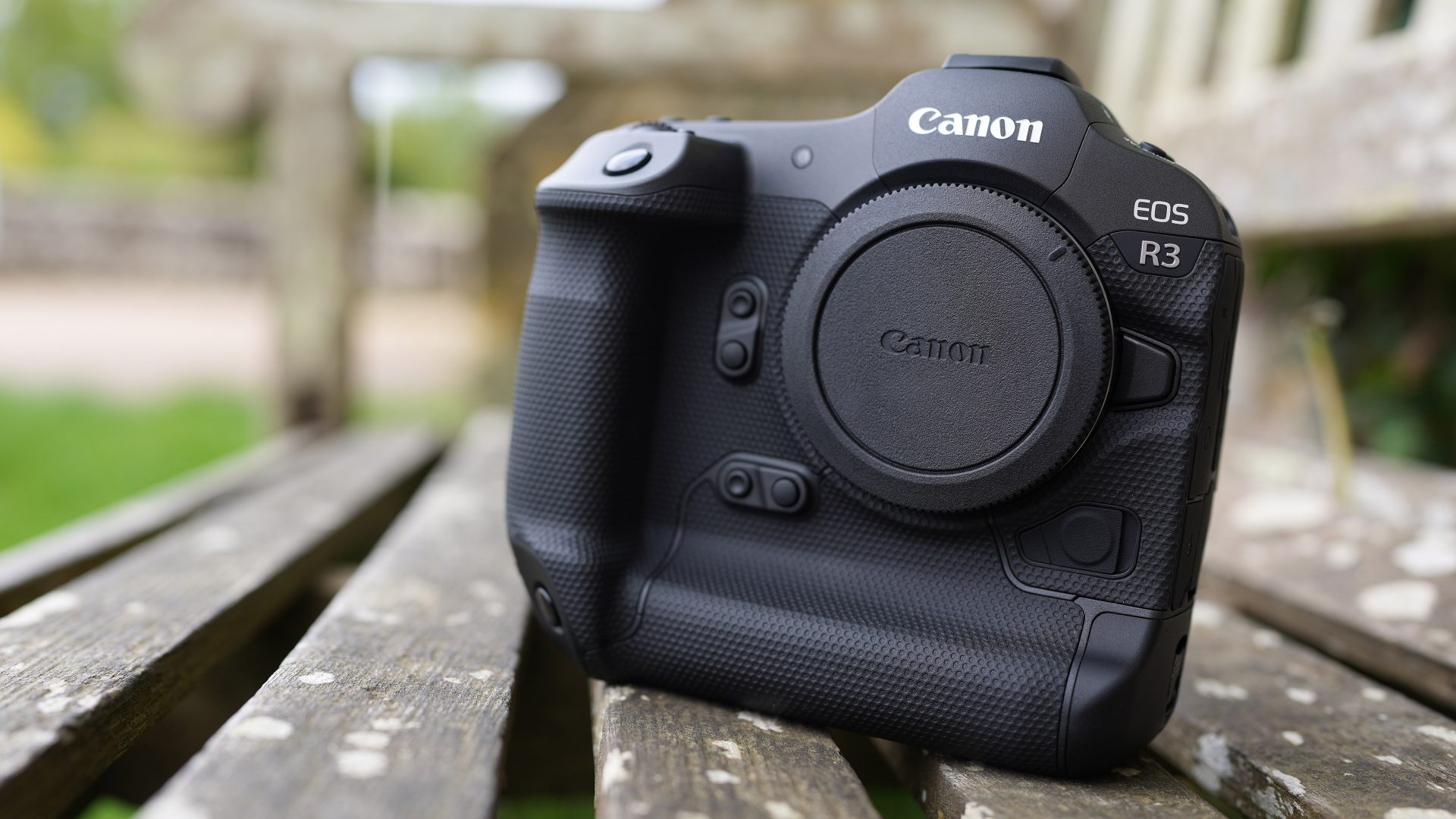Canon EOS R3 review
-
-
Written by Gordon Laing
The Canon EOS R3 is high-end mirrorless camera aimed at pro sports and news photographers who demand the fastest speed and toughest body. Teased in April 2021, and officially launched six months later, it’s Canon’s most powerful mirrorless camera to date, and while it outperforms the 1Dx Mark III in most respects, it’s officially positioned between it and the EOS R5, implying a 1-series mirrorless may come in the future.
The R3 features Canon’s first stacked backside-illuminated full-frame sensor, and I confirmed it’s designed and manufactured by Canon. To balance resolution speed and noise, Canon’s opted for 24.1 Megapixels, coincidentally the same Sony chose for their first stacked full frame sensor in the A9, three years previously. But Canon’s sensor shoots 50% faster than the A9, supporting electronic bursts up to 30fps with autofocus and auto exposure. So the R3 matches the top speed of the Sony Alpha 1 albeit capturing half the total pixels per frame.
I’ve so much to show you I’m splitting my R3 review into two videos below. In the first one, I’ll show you around the camera and controls, including the genuinely impressive eye-control autofocus system, while in the second video I’ll take a deep dive into the photo and movie quality. If you prefer to read a written version of the highlights, keep scrolling!
When shooting at 30fps, the R3’s buffer can record up to 540 JPEG or 140 RAW files, and unlike the R5 and R6 which demanded sufficient battery charge to unlock their top speeds, the R3’s big battery eliminates that limitation. No need for a green H+ icon here, and as you’ll see later, there’s minimal skewing due to rolling shutter. Switch to the electronic first-curtain or fully mechanical shutters and the top speed falls to 12fps, but means you can now essentially keep shooting JPEGs or RAWs until you run out of memory.
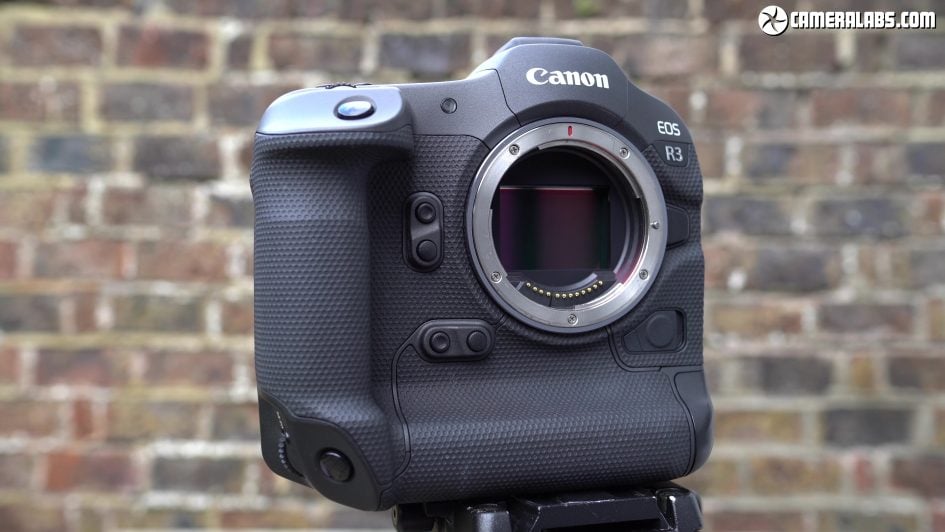
Above: Like the R5 and R6, the sensor’s stabilised within the body and can work alongside lenses with optical IS to deliver up to 8 stops of compensation. This varies with the lens and I show some examples in my second review video.
In terms of exposures, the R3 offers shutter speeds from 30 seconds to 1/8000 with the mechanical shutter or an industry-leading 1/64000 if you switch to the electronic shutter. At the other end of the scale, the Bulb timer allows you to dial-in easy long exposures from one second to 100 hours, while a built-in interval timer can capture shots at one second to 100 hour intervals. Meanwhile the flash sync speed is 1/250 with the electronic first-curtain, 1/200 with the fully mechanical shutter, and in a first for Canon, the R3 will now also sync with the electronic shutter at 1/180. Sony also now supports an electronic flash sync on the Alpha 1 at 1/200.
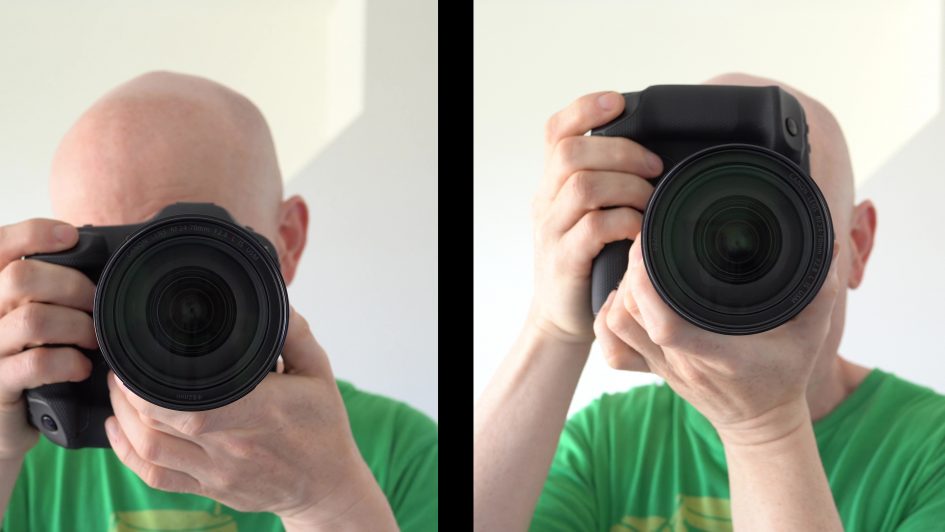
Above: Like the 1 series, the EOS R3 features a built-in portrait grip with duplicate controls, making it comfortable to hold and use whether shooting in the landscape or portrait orientation, although interestingly it does lack the third strap lug of the 1Dx that allows it to hang around your neck when turned for portraits. Amazingly the R3 only becomes the third mirrorless camera with a built-in portrait grip, following the Olympus EM1X and Fujifilm GFX-100, although Nikon’s upcoming Z-9 also sports one, leaving Sony and Panasonic as the odd ones out.
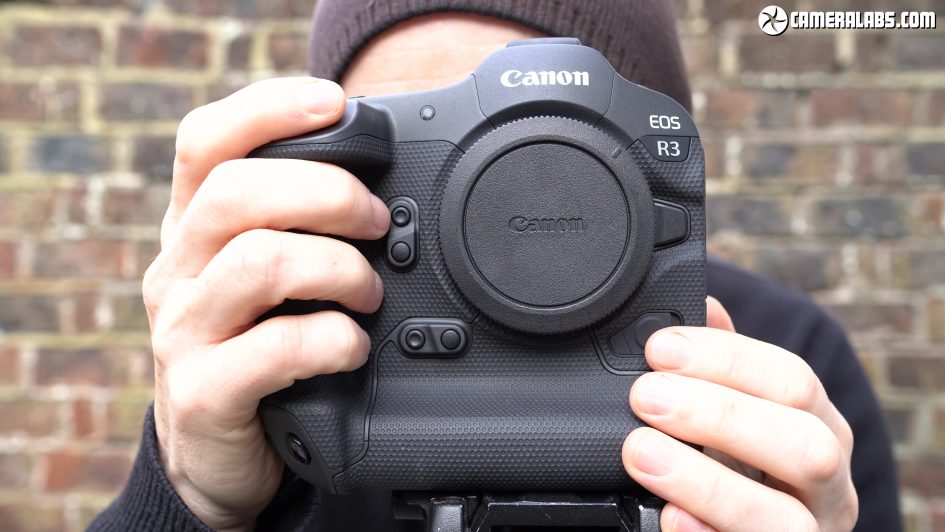
Above: At first glance the R3 unsurprisingly looks a lot like the EOS 1Dx Mark III, but in-person it’s more compact, roughly 1cm narrower, 2cm shorter and almost a quarter of a kilogram lighter. Don’t get me wrong, it’s still a substantial camera, but to me felt a lot more manageable than the 1Dx III and something I’d be happier to carry for long periods, especially coupled with one of the lighter RF lens designs. It also feels as solid as a 1 series with Canon claiming the same degree of dust and weather resistance, making it their toughest mirrorless camera to date.
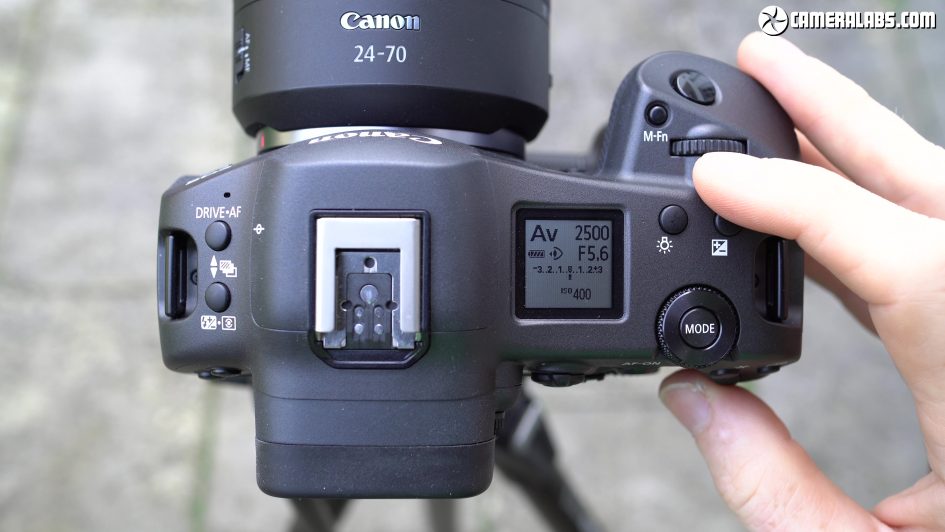
Above: From the top, the R3 takes inspiration from both the 1Dx III and the R5. On the right side you’ll find the same info screen as the R5 which can show two screens of information with the choice of reversing the text and background colours. The main adjustments are performed by the front finger dial, thumb collar and the thumb wheel on the rear. Like the R5 you change the exposure mode by pressing the Mode button and turning a dial, but this time the switch to video is with a dedicated collar control on the rear. Then on the upper left, the R3 takes inspiration from the 1 series with two buttons working alongside the two top dials to adjust the Drive and AF modes, Metering and Flash compensation, or after pushing both buttons, exposure bracketing, available here in 2, 3, 5 or 7 frames.
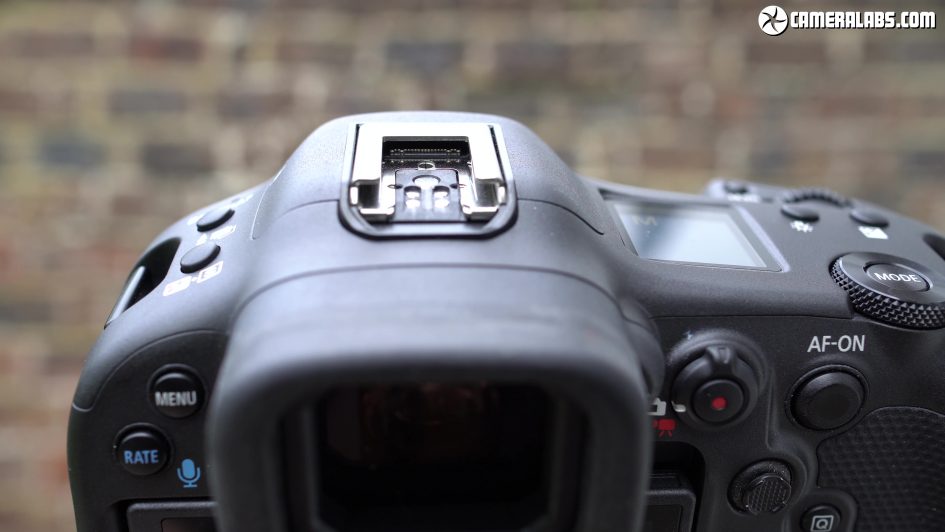
Above: Meanwhile beneath a long sliding cover on the top you’ll find the new accessory shoe which in addition to the standard five pins now includes an additional 21 under the front lip. This was first seen on the recently-launched XF605 camcorder and provides communications and power to upcoming accessories. These include a new DM-E1D microphone that doesn’t need an audio cable or its own battery, or the ST-E10 Speedlite transmitter that’s smaller because it can now use the camera controls and menus; Teac has also already announced the first third party accessory for the shoe with an XLR audio adapter.
There is one small catch though: removing the hotshoe cover compromises the R3’s full weather-proofing, but Canon’s thought of that and also offers the AD-E1 adapter that allows you to mount a Speedlite flash to the R3 while maintaining a weather-proof seal. It would also be remiss of me not to mention that Sony thought of a multi-interface accessory shoe a long time ago, but it’s still nice to have one here.
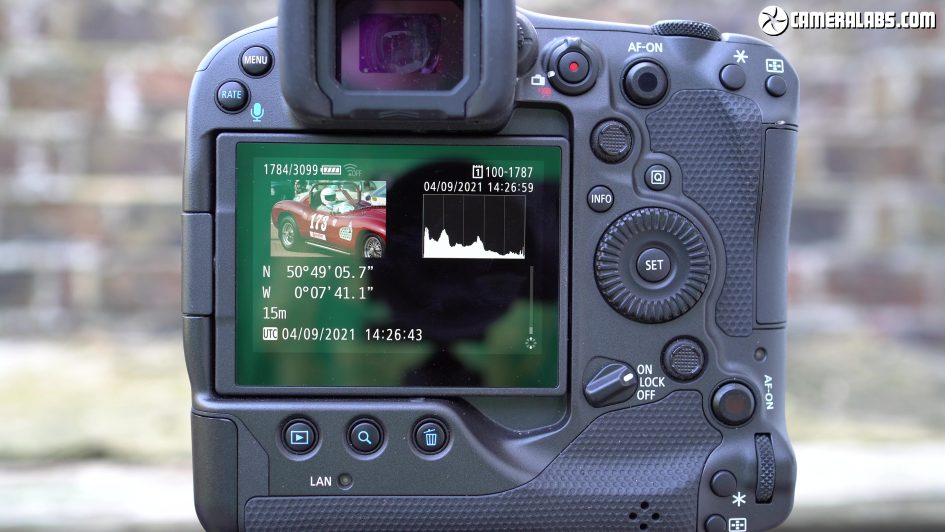
Above: Unlike most new cameras, the R3 also includes a hardware GPS receiver, doing away with the need to pair the camera with your phone just to record your location. You can set it to periodically check its position, or only when the camera is fully-on. Here’s the coordinates displayed during playback.
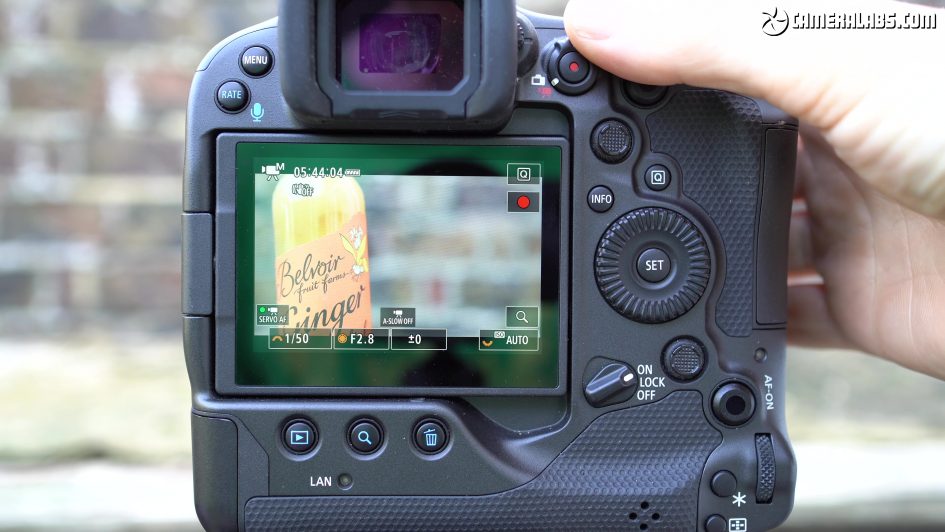
Above: From the rear you’ll see the R3 inherits some of the 1Dx III controls, including a similar power switch and the Smart Controller that made its debut on the flagship DSLR – I’ll show you how that works in a moment. I’m also pleased to find the collar control by the viewfinder to switch between stills and video, less fiddly than toggling with the Mode and Info buttons on the R5. The shorter height of the R3 means there’s no room for the secondary LCD status screen which sat below the main monitor on the 1Dx III, and sadly none of the buttons are backlit either which feels like a missed opportunity.
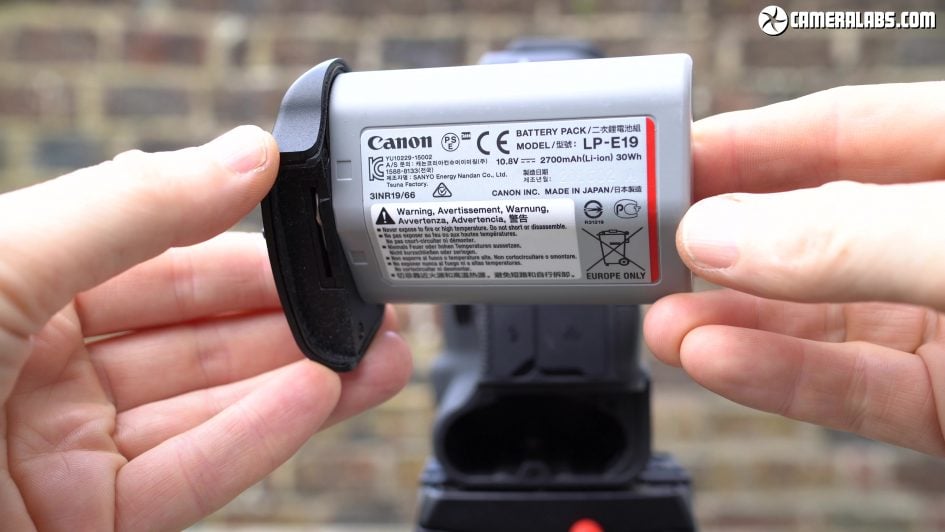
Above: In terms of power, the R3 uses the same LP-E19 battery pack as the 1Dx Mark III, allowing owners of the DSLR to swap or share batteries. It’s rated at 2700mAh, so roughly one third more than the LP-E6NH for the EOS R5 and R6, and higher voltage too, allowing it to drive the recent RF super-telephoto’s autofocus systems faster. Canon quotes up to 620 shots with the viewfinder or 860 with the screen. If you mostly shoot bursts with the electronic shutter you could get way more though: I managed almost 2000 frames with several minutes of slow motion video on a charge
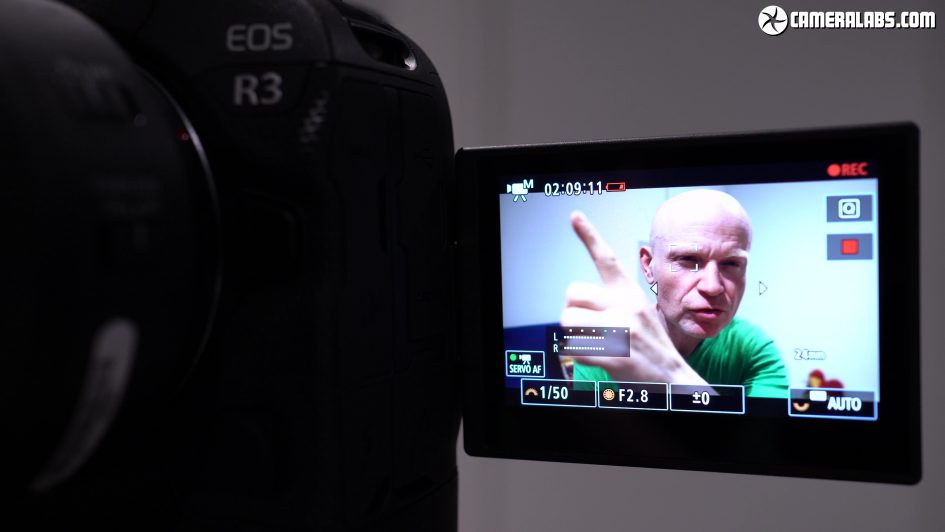
Above: In terms of video alone, I could record two hours and 12 minutes of 4k 25p on a single charge, and in a single clip – yes, no more 30 minute limit – and with no overheating either. I’ll talk more about that later.
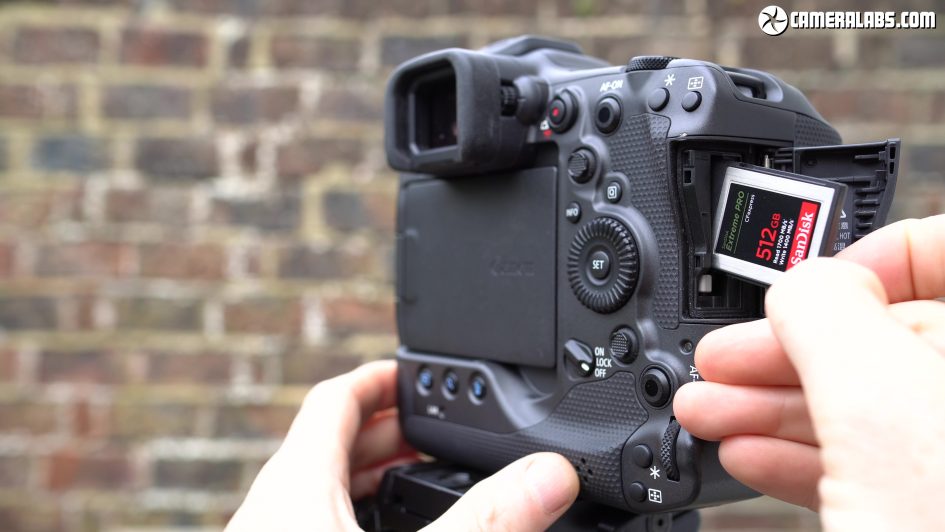
Above: Behind a door on the grip side are the same dual card slots as the R5, supporting SD UHS-II and CF Express Type-B, and as you’d hope the R3 allows simultaneous recording to both cards from day-one. There are a couple of high bit-rate exceptions though: 4k in All-i at 50 to 120p is too much for SD at Canon’s generous bit rates, as are all of the RAW video options, but otherwise you can record anything to the SD card or to both cards simultaneously. And if you do opt for RAW, you can record it to the CF Express card and an MP4 proxy to the SD.
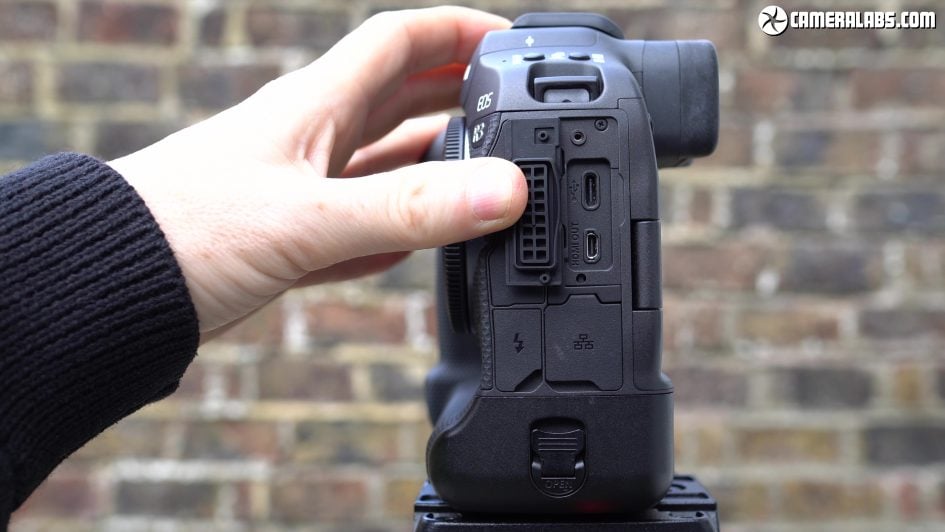
Above: On the left side you’ll find the ports: 3.5mm microphone and headphone jacks, USB C and HDMI, flash sync and a Gigabit ethernet port for wired networking. There’s also 5GHz Wifi and Bluetooth. The USB C port runs at 3.2 Gen 2 speeds, can charge the battery internally – I successfully used my MacBook Pro and Galaxy S20 chargers – and can now support Apple MFI-certified connections to iphones or ipads for 3rd party apps. Annoyingly despite the size of the body, Canon has doggedly stuck with a Micro HDMI port. It’ll output 10 bit 4:2:2 video, and while there’s no confirmation on RAW output yet, I’d be surprised if the R3 isn’t squirting RAW video in 6k to a Ninja V+ at some point in the future.

Above: Composition is with either an electronic viewfinder or a screen. I’ve filmed the EVF here which shares the same 5.76 million dot panel as the R5, so that’s 1600×1200 pixels with 0.76x magnification. This makes it less detailed than the Alpha 1 viewfinder, but it still looks great in use and runs at either 60fps in a power saving mode or 120fps in a smooth mode. Like all EVFs you can display a wealth of information, preview exposures and effects, navigate menus and playback images. When shooting fast bursts, there’s no blackout or perceptible lag. The R3 also offers an optical viewfinder simulation which doesn’t preview exposure if you prefer that look.
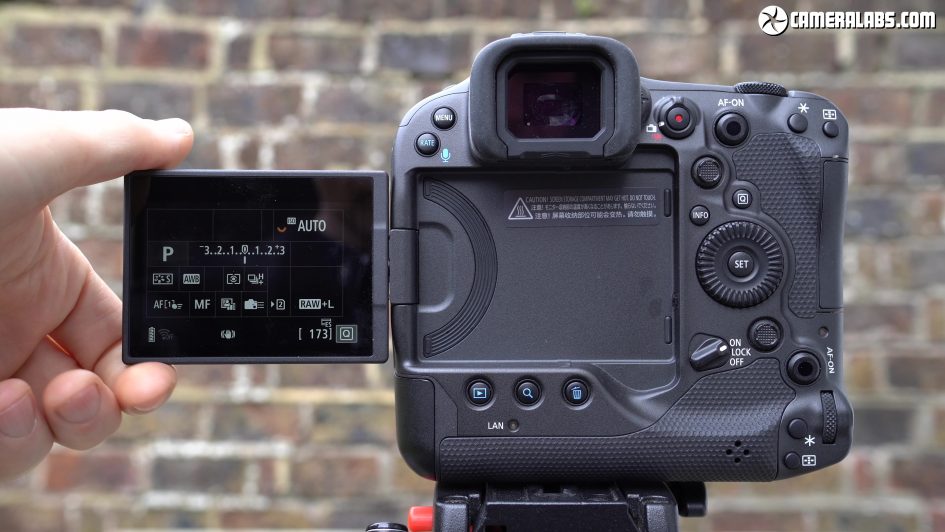
Above: Turning to the screen, the R3 employs a 3.2in panel with a higher than average 4.15 million dots for a more detailed image. Unlike the fixed screen on the 1Dx III, the R3’s is fully-articulated, flipping out to the side and twisting to almost any angle. It’s an interesting decision and only time will tell if it impacts the overall robustness, but as a fan of this type of screen I’m not complaining.
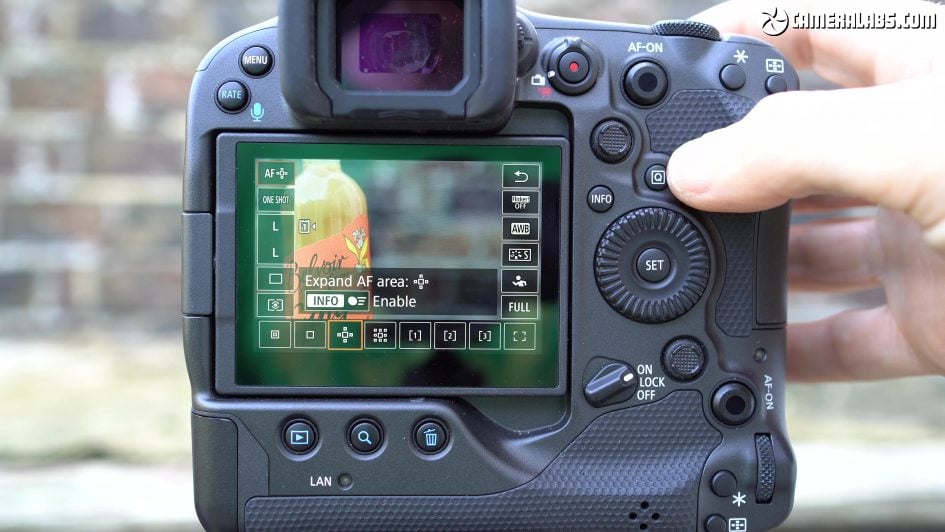
Above: Moving onto autofocus, the R3 lets you choose between a wealth of areas from the full frame to three zones, single area with various expansions and spot for precision, and the Dual Pixel CMOS system is as fast, confident and accurate as you’d expect for a camera aimed at pro sports. But what makes the R3 stand out are the options for positioning the AF area. First of all there’s the AF joystick which allows the usual eight-directions and for me works best for small nudges rather than attempting to scroll across the frame.
Secondly you can simply tap on the desired subject using the touch screen. For me this can be very quick but depending on your steadiness it may lack the precision of the joystick. Still great for pulling focus in movies though.
Third is the Smart Controller, inherited from the 1Dx III. This allows the AF-ON button to double as a means to quickly adjust the AF area position. It employs optical technology, working a bit like an upside-down computer mouse, but providing fast and surprisingly precise positioning of the AF area, especially when composing through the viewfinder. All three techniques also work in playback and here I’m using the Smart controller to quickly scroll around an enlarged image. Like the 1Dx III, the joystick and Smart Controllers are also duplicated on the portrait grip.
But the R3 goes above and beyond other cameras by offering a fourth means to adjust the AF area, and that’s with the new Eye Control. This takes the original concept of the eye control which made its debut on the EOS 5 film SLR in the Nineties, but completely revamps it to become both technically impressive and genuinely useful.
Canon’s deployed technology developed from its medical division on the R3, employing eight low power LEDs around the viewfinder – four at the top and four at the bottom – to accurately track the position of your eye. Not for tracking a subject but to initially place an AF area or select between subjects.
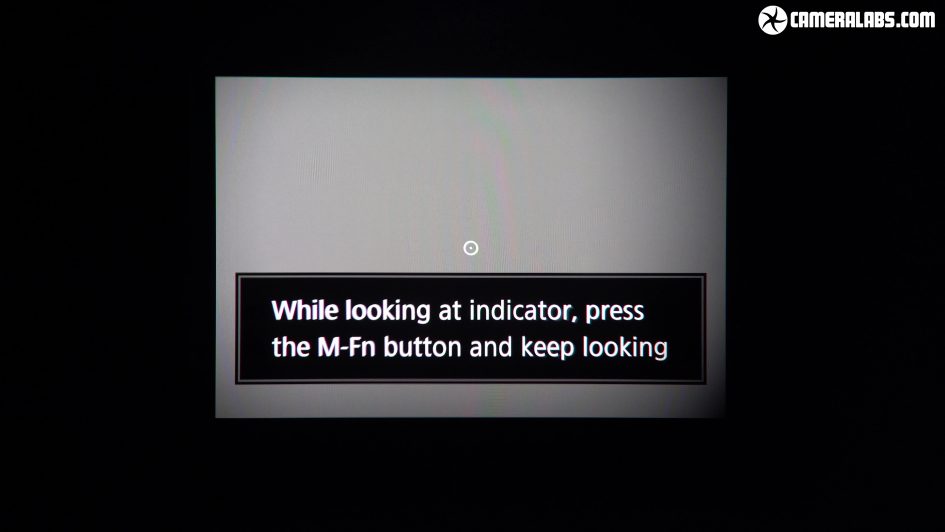
Above: You’ll first need to calibrate the system by looking through a target in the middle of the viewfinder while pressing the M Fn button. Once the system is happy it’ll repeat the process four more times, moving the target to the right, left, top and bottom. I can’t film the rest of this process though as it requires your eye to the viewfinder.
You can then repeat the process multiple times to refine the accuracy or for when holding the camera in the portrait orientation. Canon recommends recalibrating for different conditions, such as when shooting in a new venue, but the process only takes a minute or so.
Now I’d love to show you the system working in practice, but it’s only displayed in the viewfinder and only works when an eye is against it, and annoyingly the HDMI output is disabled when you’re using the viewfinder, so beyond some demos from Canon I’ll just have to describe it to you.
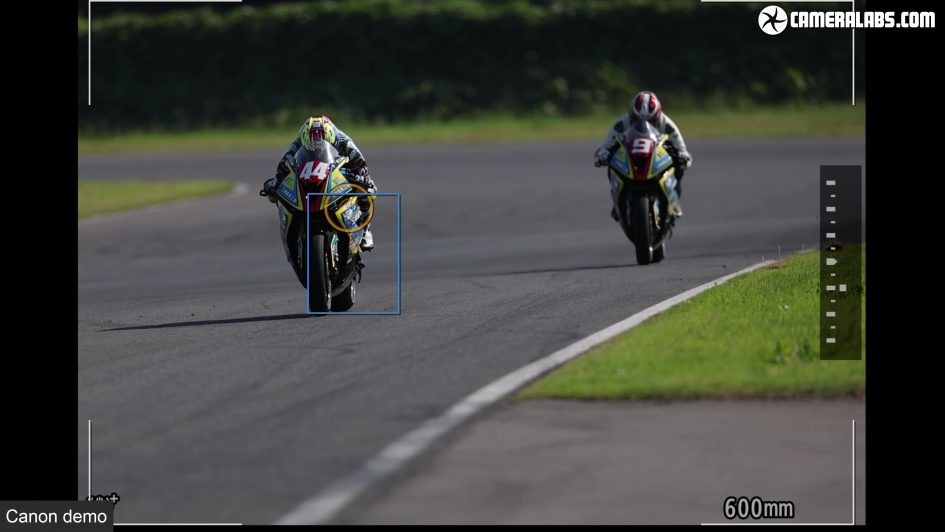
Above: After calibrating, you’ll see a small orange circle with a smaller concentric ring inside darting around the frame and following your eye with surprising accuracy. Indeed after calibrating the system twice, I found I could position the target very precisely, picking out individual faces in a crowd. This target is then used to tell the camera where it should start focusing, so with a half press of the shutter the R3 takes over and the circle target disappears until you let go of the shutter.
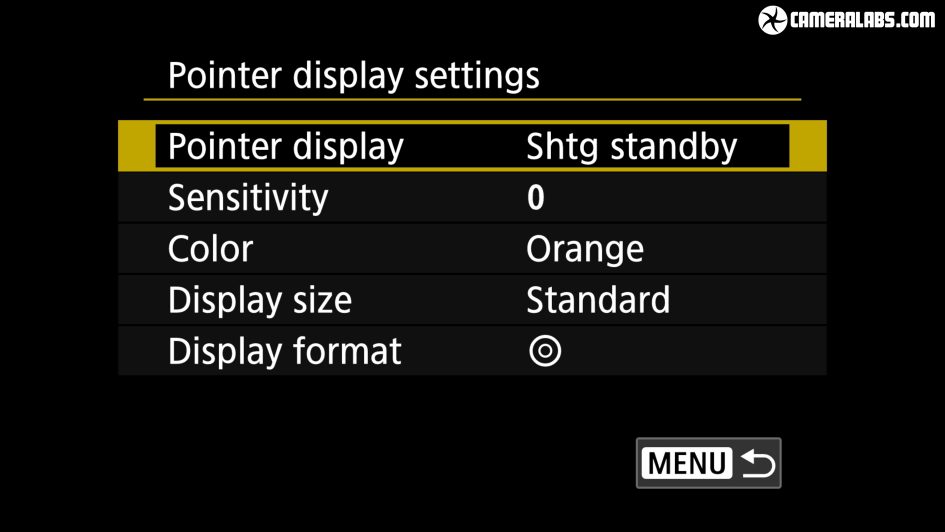
Above: A series of options lets you choose if the target is visible all of the time, none of the time or only prior to a shutter press. You can also change the size, style and colour of the target as well as storing up to six calibration banks for different people. I initially thought I might need a second bank when using reading glasses, but the R3 proved accurate whether I wore them or not.
I tried out the R3 for a variety of sports, action and wildlife and found the eye control was a game changer for team sports where I could reposition the AF area in an instant by simply glancing at the player then pushing the shutter. It’s almost like a video game and in this scenario is by far the fastest way to reposition the AF area especially if the action suddenly moves to the other side of the frame. And once you commit with a half push of the shutter, the R3’s refined AF algorithms do a brilliant job at tracking the subject, but again you only need to let go and glance for an instant to adjust if necessary.
I also found it was effective for street photography or even just shooting around town when you regularly want to move the AF area to opposite sides of the frame.
I’m sure the mileage will vary for different people, but if it works for your eyes as well as it did for mine, then it gives the R3 a major advantage over rivals and you’re in for a treat.
Canon EOS R3 photo and video quality
Now for the second part of my review, where I’ll examine the photo and video quality of the EOS R3. All the results I’m showing you were made with a pre-production EOS R3 and Canon was happy for me to share all of them with that caveat. I plan to make an updated quality review with a final production model when they become available, but for now the fact Canon is happy for me to share these results suggests to me my pre-production sample was close to final quality.
Let’s start with image quality. The EOS R3 sports Canon’s first full-frame back-illuminated stacked CMOS sensor, which is a complicated way of saying it has fast output, in turn supporting quick bursts with minimal skewing when using the electronic shutter.
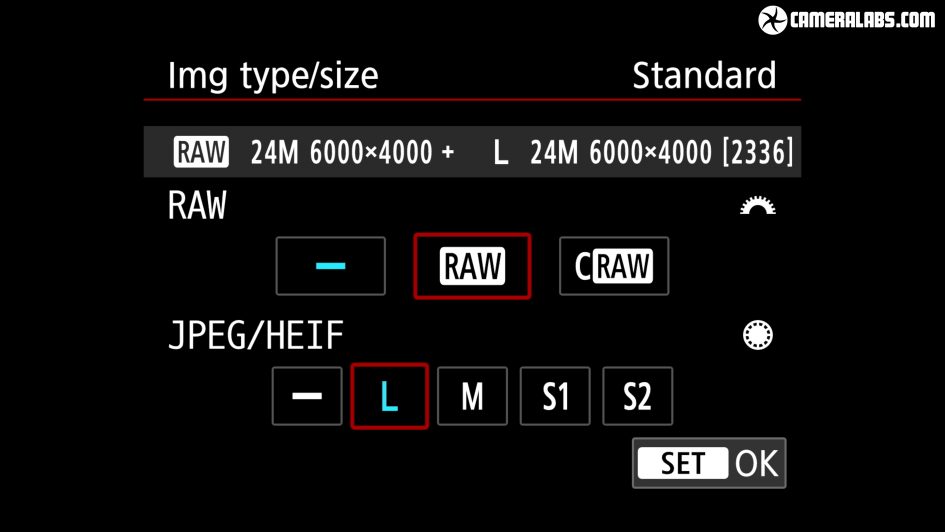
Above: Canon’s opted for 24.1 Megapixels, like Sony’s original A9, for a balance of resolution, noise and speed. You can choose from the full 6000×4000 pixels or three lower resolutions, and for JPEGs you can set the compression level for each size in ten increments. 14-bit RAW files are available in full or compressed C-RAW versions, and there’s the option to switch JPEG for HEIF in 10 bits if desired.
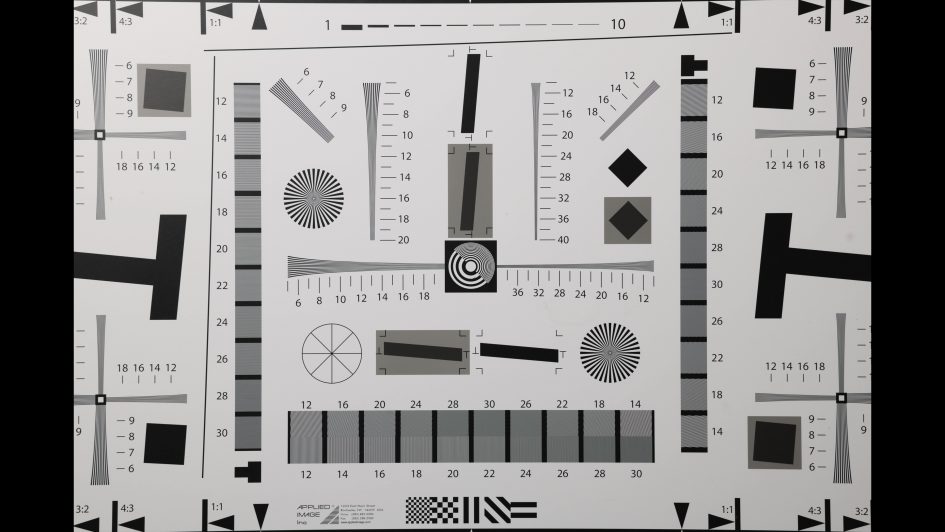
Above: For a meaningful comparison against some rival models, I’m going to turn to the resolution chart. So here’s the EOS R3, with the RF 24-70mm f2.8 at 50mm f8 and in this video I’m showing you JPEGs from a pre-production model. Once the camera and RAW converters come out of beta, I’ll make another comparison for you.
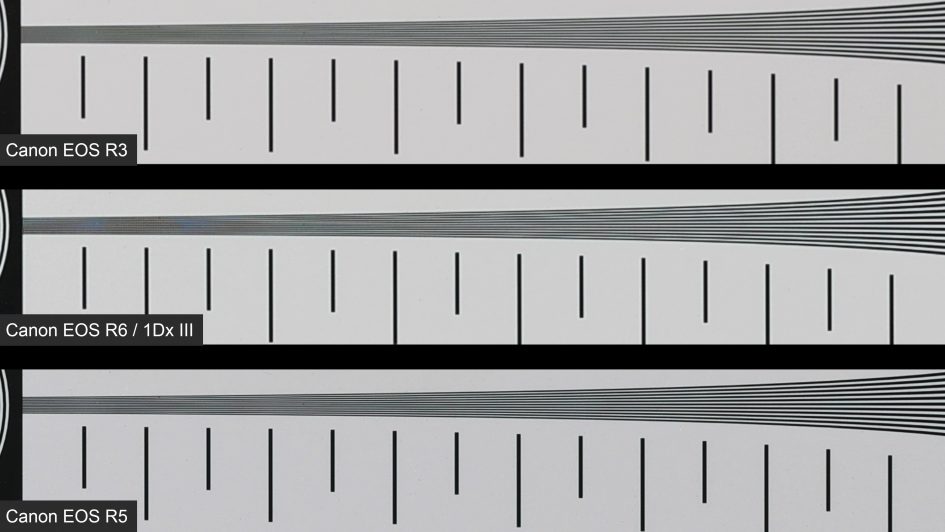
Above: So here’s a closer look at the R3 chart at the top, with the R6 representing itself and the 1Dx III in the middle as they share the same 20 Megapixel sensor, and finally the 45 Megapixel EOS R5 at the bottom. As you’d expect the R5 comfortably out-resolves both the R6 and R3 thanks to its considerably higher resolution, so if you’re into fine detail or cropping small areas, it’s the model to aim for. And while the R3 is visibly resolving slightly higher detail than the R6 / 1Dx III sensor, it’s not by a significant margin. The R3 does of course have other benefits like speed, but if you’re into detail alone, I’d say the R3, R6 and 1Dx III are roughly equivalent.
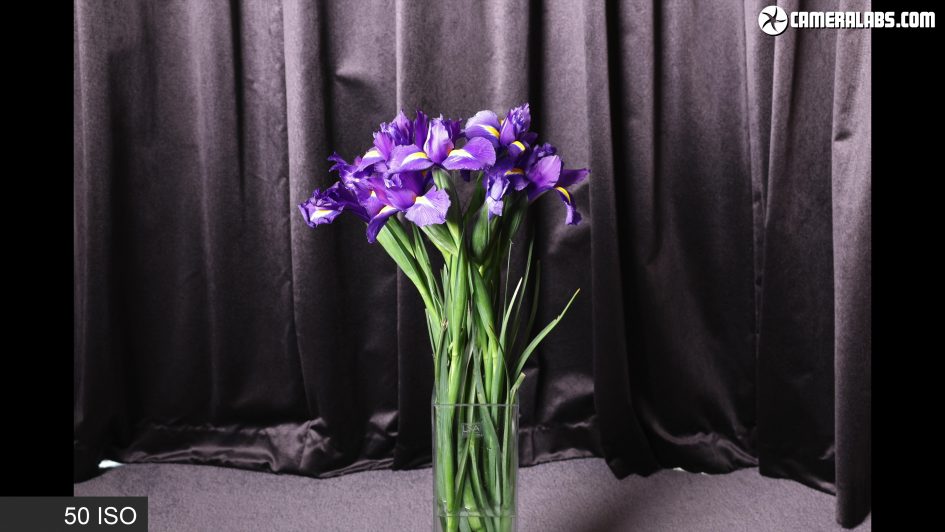
Above: To evaluate noise I photographed this bunch of flowers using the R3’s full ISO range from 100 to 102400 ISO along with the extended options of 50 and 204800 ISO.
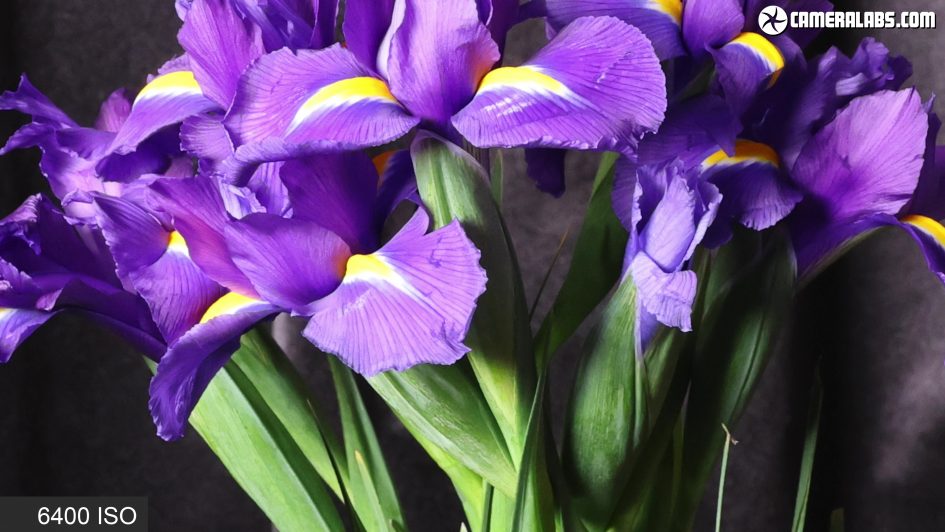
Above: I’ve presented crops at each setting in my review video, but here’s the crop at 6400 ISO. Again from a pre-production sample.
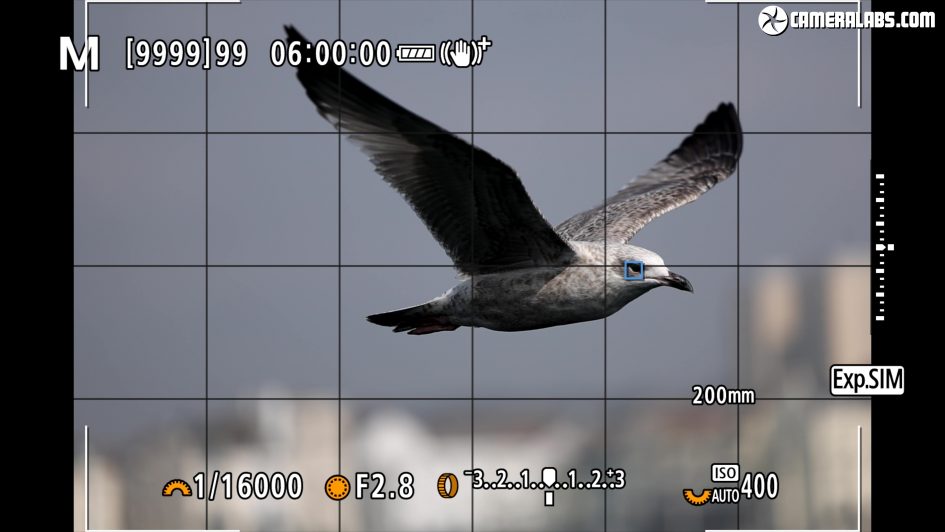
Above: Alright now for autofocus and I wanted to start with birds and to show the subject and eye detection in action I recorded the HDMI output of the R3 fitted with the RF 70-200 2.8. Like the R5 and R6 before it, the R3 can easily recognise and track animals, even locking onto their eyes if they’re close enough. I found it worked really well for Brighton’s seagulls simply with the widest AF area enabled and letting the technology do the rest. No need for the R3’s eye control here.
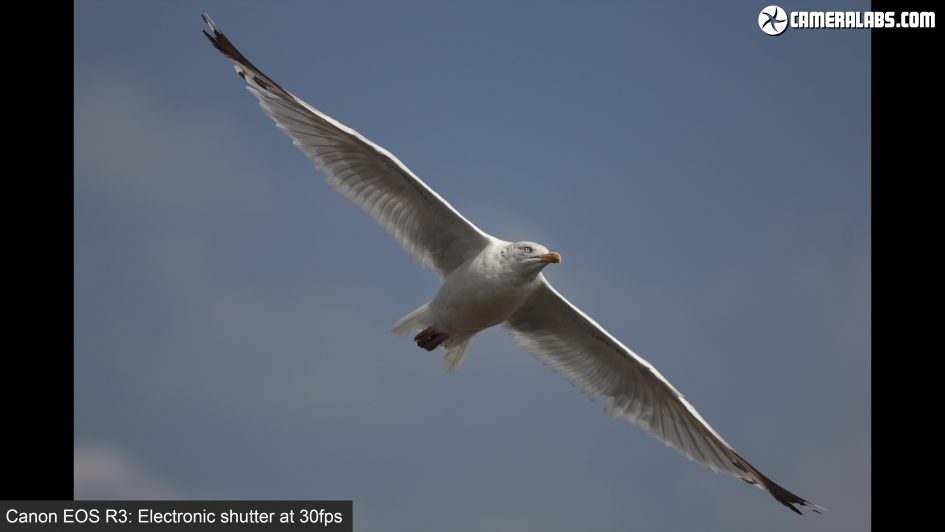
Above: Here’s a selection of images I shot with the R3 and RF 70-200, mostly at 200mm f2.8 and again using the Wide AF area with animals selected as the subject type. Unlike Sony, Canon doesn’t ask you to differentiate between birds and other animals. I used the electronic shutter here in H+ where it consistently delivered the top 30fps frame rate even with Continuous Servo AF. So I was ending up with 50% more images than the R5 at its top speed, but more importantly, the faster readout of the sensor meant lower rolling shutter and less skewing as I panned to follow the birds swooping past buildings. I was also able to exploit shutter speeds up to 1/64000. But of course the R3 lacks the higher resolution of the R5, so there’s less opportunities for big crops.

Above: Next for cars as the R3 now features a new subject tracking option for cars and bikes, and as luck would have it, there was a drag racing event on in Brighton as I tested the R3. For starters, here’s some mostly static shots of some cars to show the vehicle detection in action.
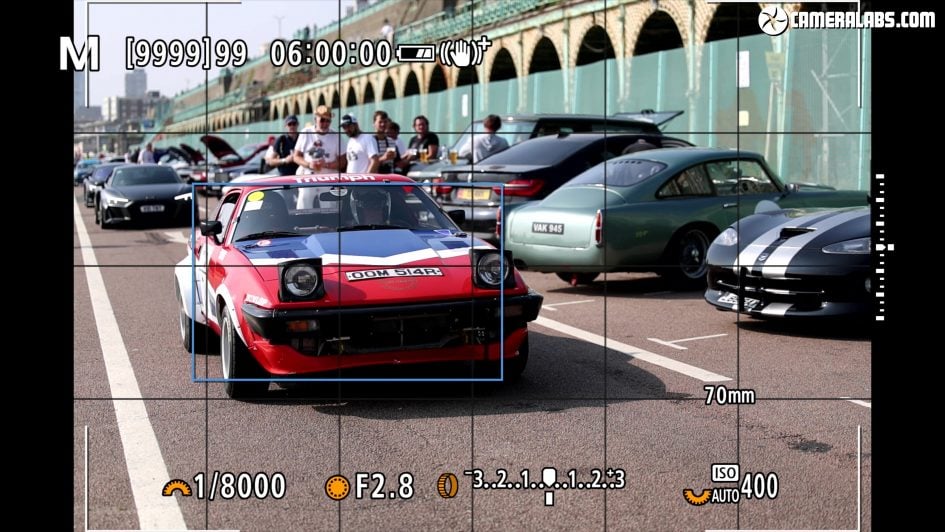
Above: Canon also make a big deal about you being able to choose whether the camera should focus on the vehicle or helmet, but in my tests with a pre-production sample, it only found a helmet behind the windscreen once. There is an option for ‘spot detection’ when selecting vehicle in the AF menus, but it didn’t make a difference in my tests here.
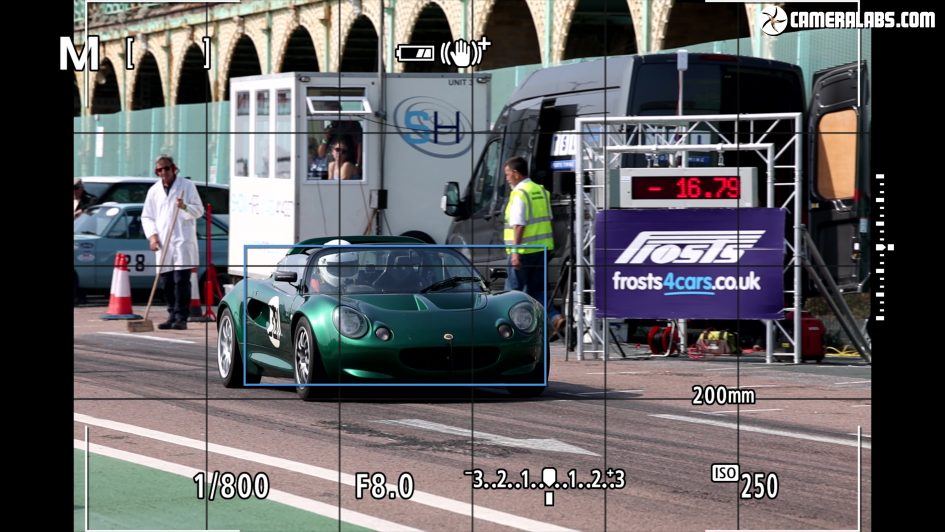
Above: And now for the AF system in action with the cars starting their races. Unfortunately race rules prevented me from being further along the track so you’re only seeing the first few seconds of each race, but you can still see the camera recognising and tracking the vehicle shape. Again this is something I look forward to retesting with a final production model in my next update about the R3. I’ll show you some of the still photos from the event later.
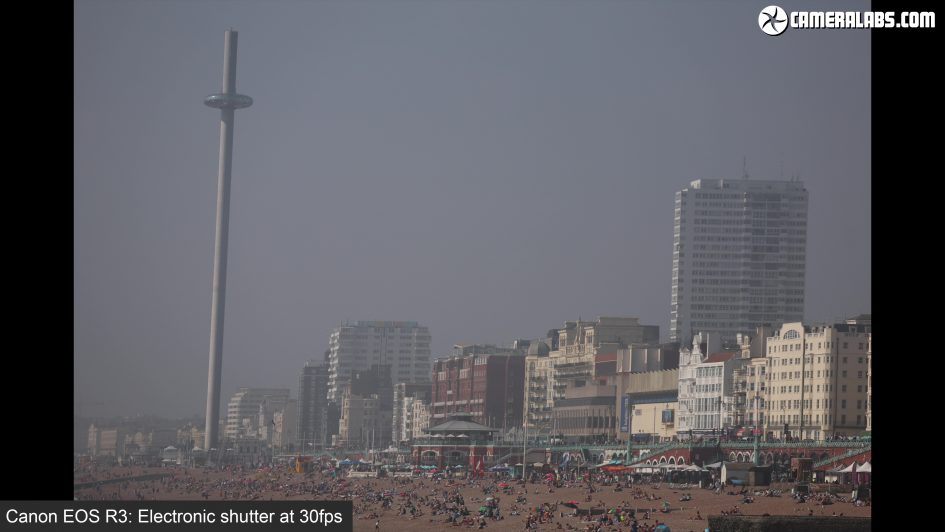
Above: As I’ve mentioned, the R3’s stacked CMOS sensor has faster readout and reduced skewing, so to put it to the test, here’s a fast pan I made using the mechanical shutter where all the buildings are of course upright, followed by a pan made with the electronic shutter which looks slower as it was shooting more fps. You can see very minor skewing on the tower, but it’s pretty well-behaved. Here’s another pan across the tower with a longer lens using the electronic shutter where I’d say the skewing is roughly equivalent to the Alpha 1, both of which are a huge improvement over the R5 and R6, making their electronic shutters and top burst speeds much more practical.
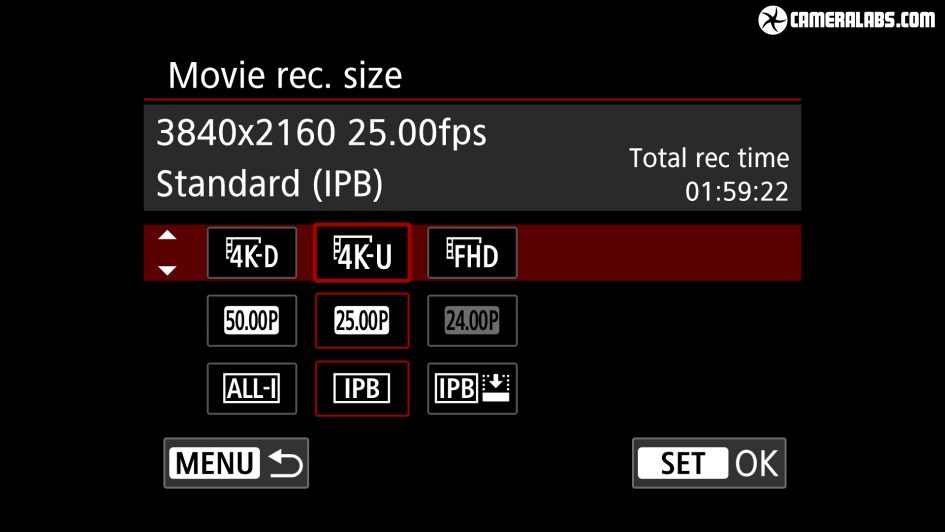
Above: I’ll show you more sample images with the R3 at the end of the video, but now it’s time to look at the movie mode, starting with the quality options when the camera is set to PAL. I’ll switch this for the NTSC options below.
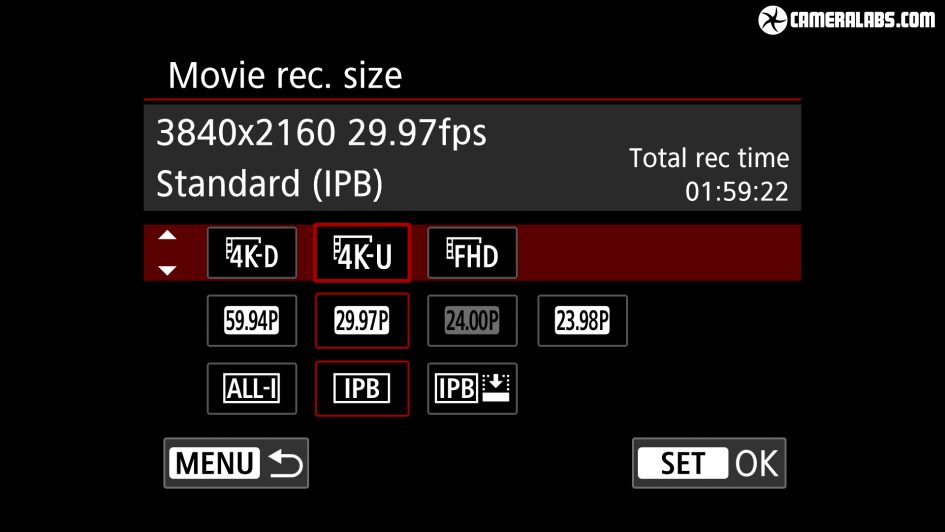
Above: So you can film in 1080 or 4k, the latter in the choice of 16:9 UHD or the wider Cinema DCi shape. In normal filming modes with sound, you can choose from 24 to 60p and in the choice of IPB, IPB Light or All-i encoding.
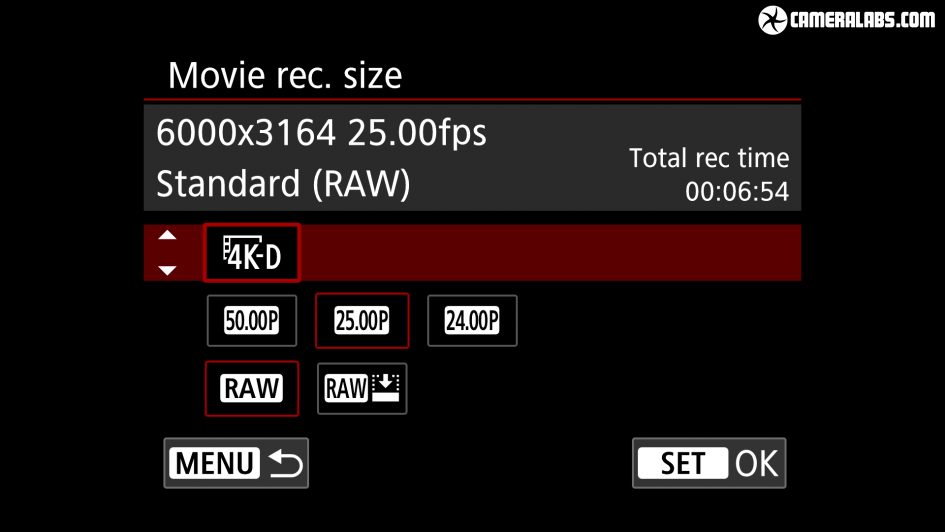
Above: You can also set the camera to record 12-bit RAW in 6k at 6000×3164 pixels and from 24 to 60p. At the time I made this video it’s only recorded internally in Canon’s CRM or Lite formats, but I hope it’ll be available over HDMI to an Atomos recorder in the future.
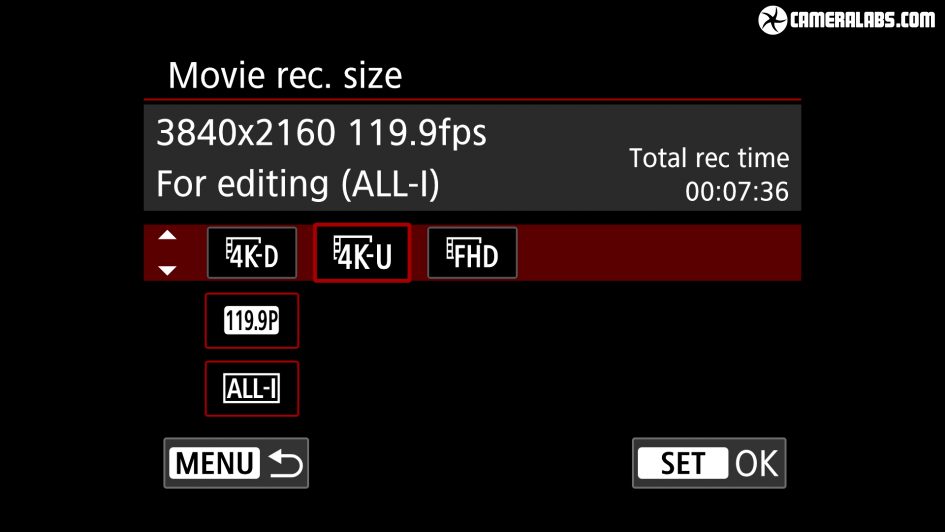
Above: Fans of slow motion will be pleased to learn the R3’s High Speed Video mode can record 1080 or 4k again in both shapes at 100p when set to PAL or 120p in NTSC. This is then slowed by four times within the camera and encoded without sound.
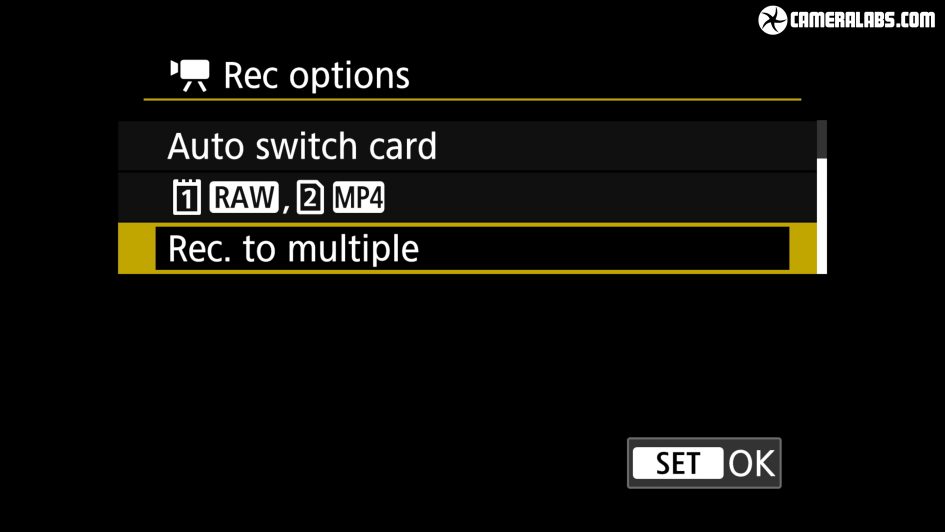
Above: The R3 has dual memory card slots for SD and CF Express and I’m pleased to report you can record most of the video formats to SD. The exceptions are 4k All-i between 50 and 120p and any of the RAW formats which all demand CF Express. Choose one of the lower bit rate options though and you can record to both cards simultaneously, and if you’d like a backup when filming RAW to CF Express, you can record a lower bit rate MP4 to the SD.
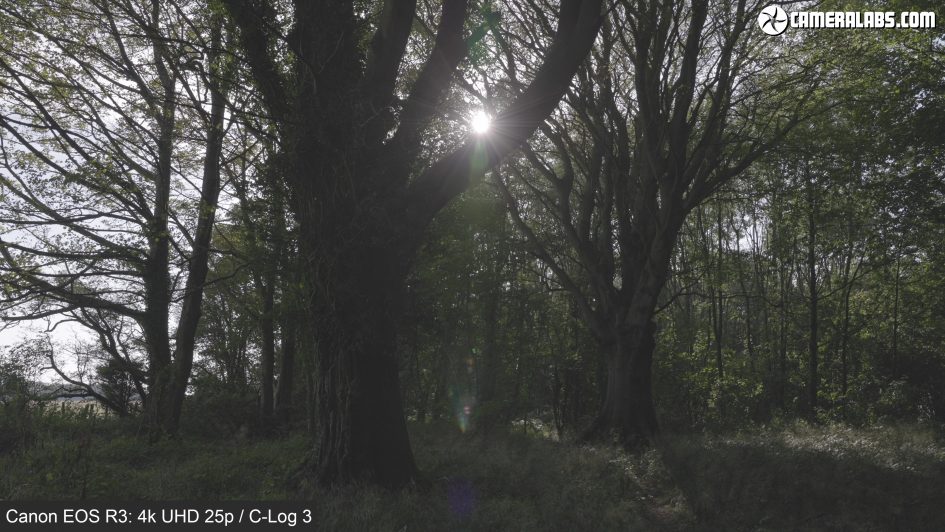
Above: Graders can also exploit C-Log 3 which records 10 bit 4:2:2 and can also output it over HDMI if desired. Here’s a clip in the standard profile and now one in C-Log 3. I’ll test the R3’s dynamic range for RAW and log video and stills when I have a final production sample.
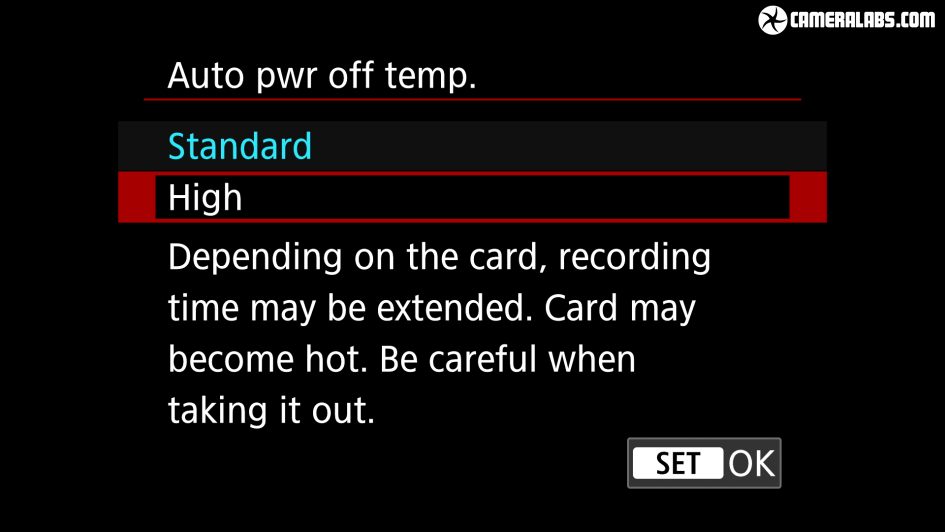
Above: And now for some really good news: the R3 can record for a long time and didn’t suffer from overheating at all in my tests, presumably thanks to the bigger body and lessons learned from the R5. But wait, there’s more:
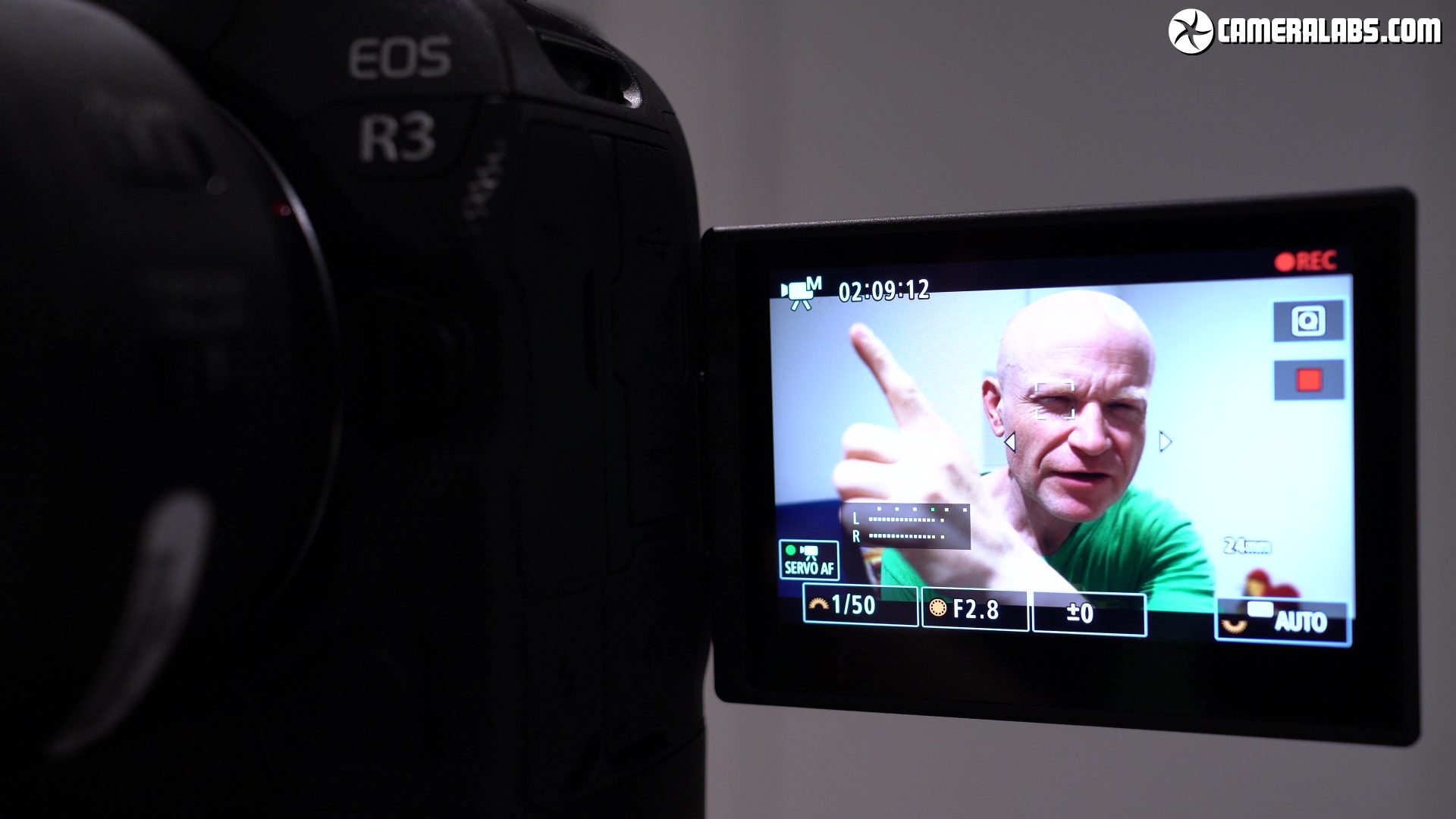
Above: In the end I managed to record a single 4k 25p clip lasting 2hrs, 12mins and 32 seconds on a single battery charge, all without overheating, and that was in a fairly warm room. As I mentioned there is now an high temperature option, but I achieved this clip length with or without it enabled.
With the battery apparently being the limiting factor, I wondered how much longer I might be able to record on external power, so with a half-charged battery, I connected my MacBook Pro USB C charger and prepare yourself for a shock.
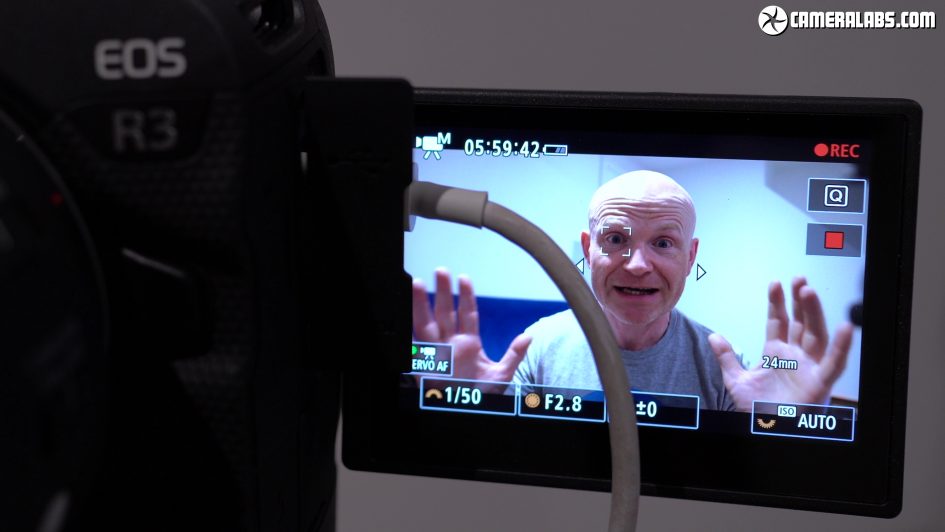
Above: Yep, six hours of 4k in a single 287 GB clip with no overheating and no hacks. Canon has finally got it right here and I sincerely hope all future Canon cameras also sail past the previous half hour limit. Sadly I suspect it won’t be offered as a firmware update to existing models though, but I’ve already put the request in anyway.
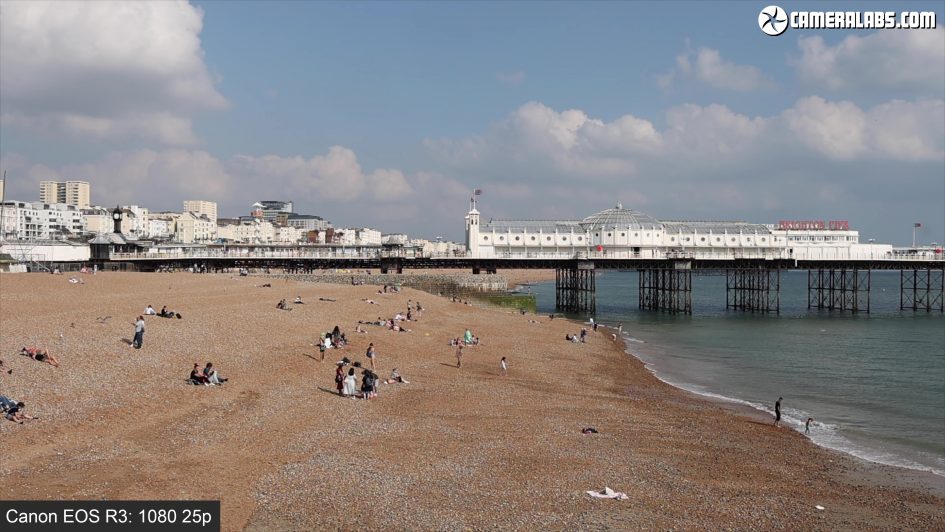
Above: Right now let’s actually have a look at some real-life footage, starting with 1080 at 25p where the R3 takes the full sensor width and scales it down.

Above: Next for 4k DCi, where the R3 again starts with the full sensor width and, according to Canon, oversamples from 6K’s worth of data; I’m showing the full width of the DCi clip here, so the wider shape means there’s black bars at the top and bottom.
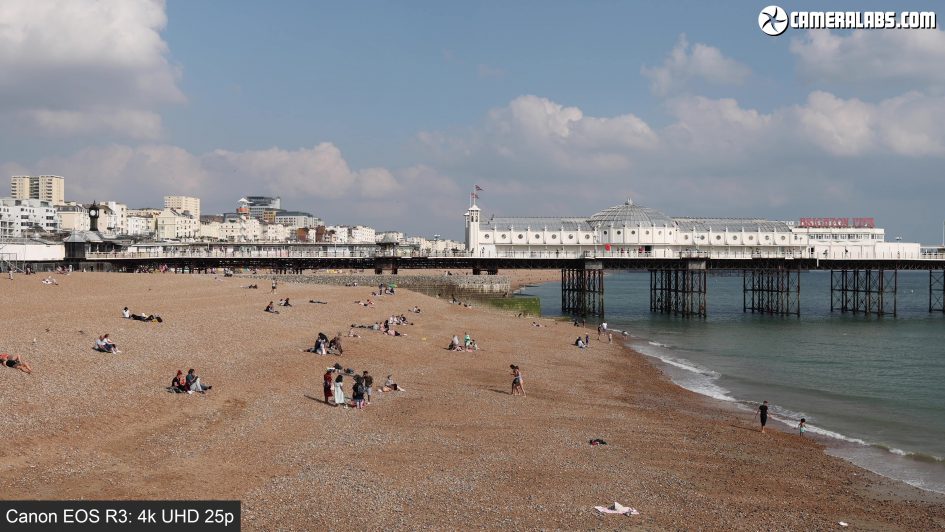
Above: And next for 4k in the slightly narrower 16:9 UHD shape which simply crops the sides from the DCi version, resulting in a slightly narrower field of view.
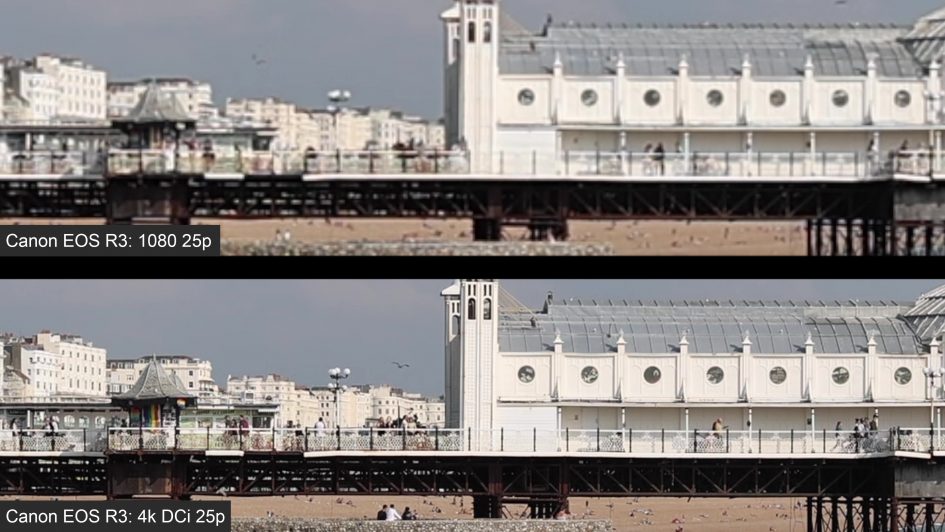
Above: Here’s a closer look at 1080 25p footage at the top and 4k DCi footage at the bottom, which both share the same frame width. You can clearly see the 4k footage out-resolving the 1080.
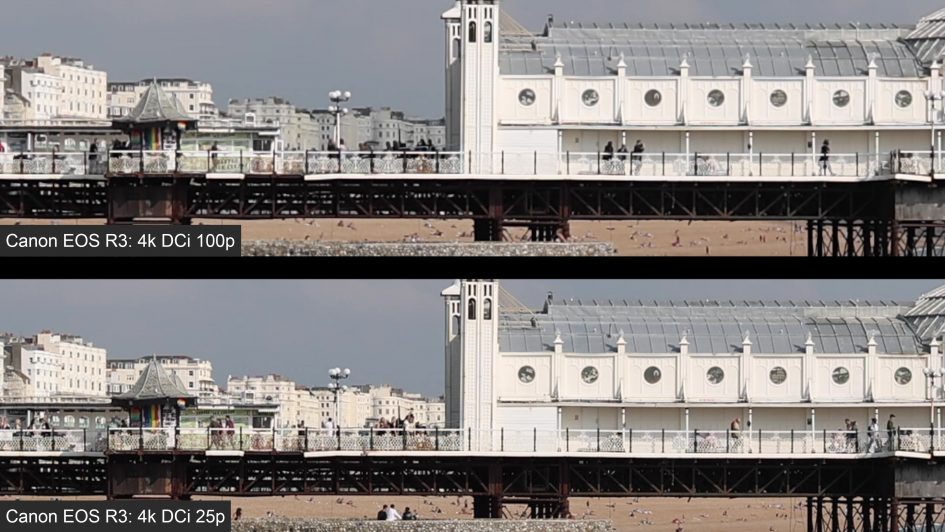
Above: And now I’ll switch the 1080 clip at the top for 4k at 100p in the High Frame rate slow motion mode, which lacks the ultimate detail of normal 4k up to 60p, but is still better than 1080 at any frame rate.
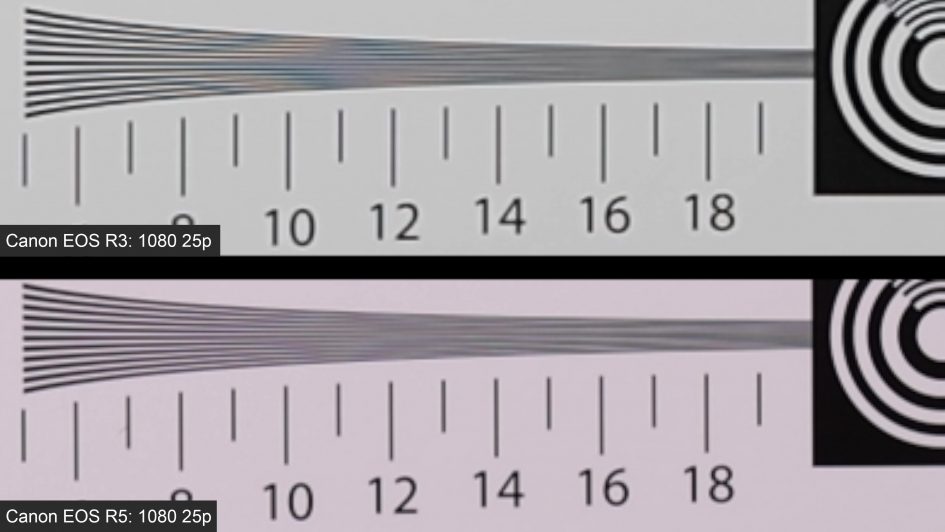
Above: To better see the differences, here’s the resolution chart filmed by the R3 in 1080 at 25p. Taking a closer look with the R3 at the top and the R5 at the bottom, both in 1080 at 25p shows the R5 taking a very slight lead, but they essentially look very similar here.
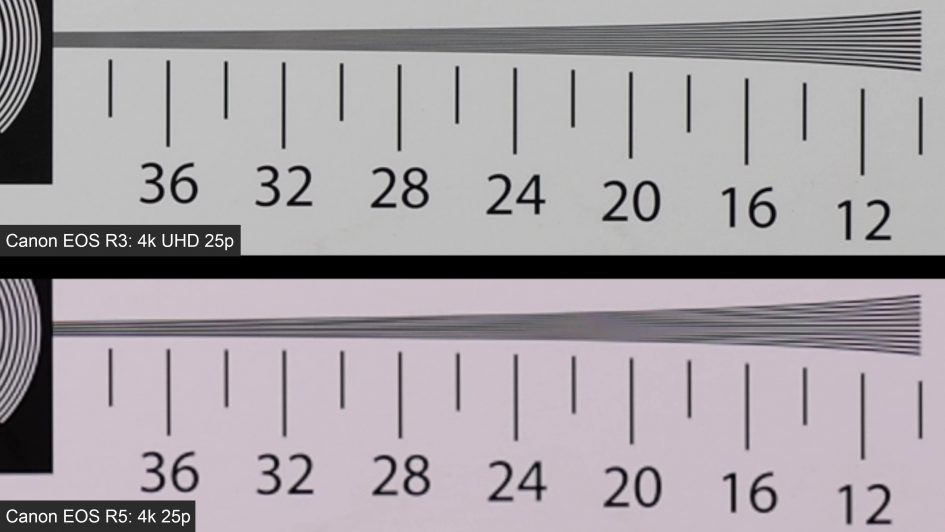
Above: Next for the R3 in 4k 25p, first with the full chart, and now a close view with the R3 at the top and the R5 in standard 4k at the bottom, both at 25p. Now the R5 generates standard 4k by line-skipping and the impact on quality here is quite dramatic with the R3’s over-sampled 4k easily out-resolving it.
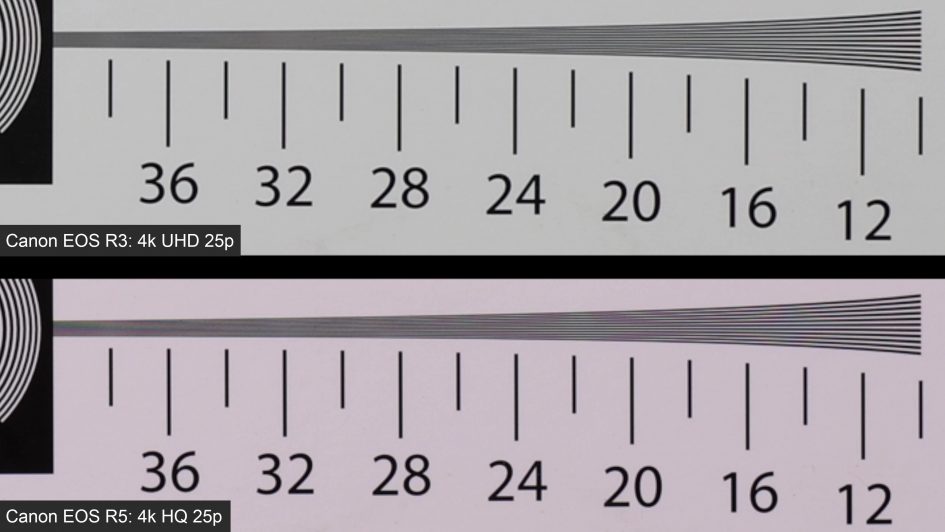
Above: Next I’ll switch the standard 4k from the R5 at the bottom with its 4k HQ mode which oversamples from 8k’s worth of data. This allows the R5 to deliver a dramatic improvement in resolution, but I wouldn’t say it’s better than the R3. They look pretty similar here, and you may even slightly prefer the R3 result, but in general use, I’d say the R3’s standard 4k can match the quality of the R5’s 4k HQ. This is great news for the R3 since all of its 4k up to 60p looks this good and it can keep recording it beyond two hours in a single clip without overheating.
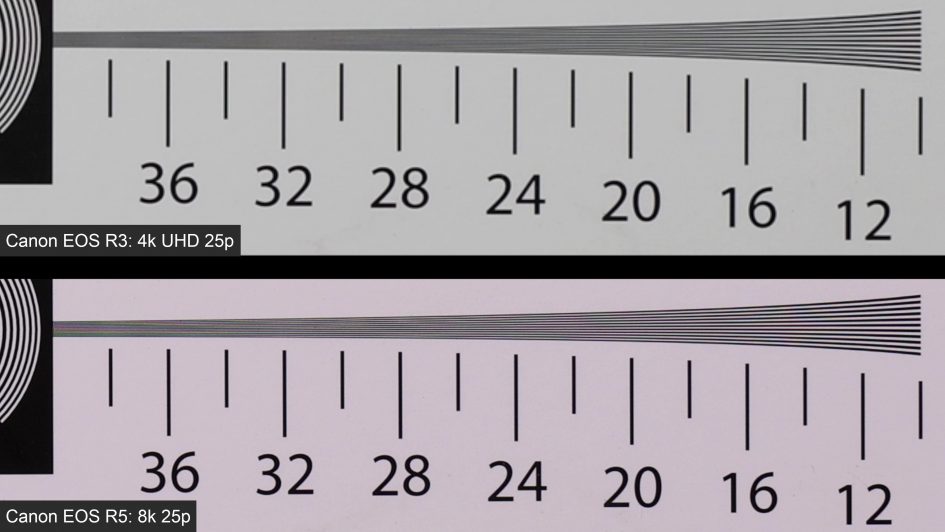
Above: Of course the R5 has a trump card with its 8k seen here in the bottom half, easily out-resolving the R3, but again with shorter clip times and greater risk of overheating.
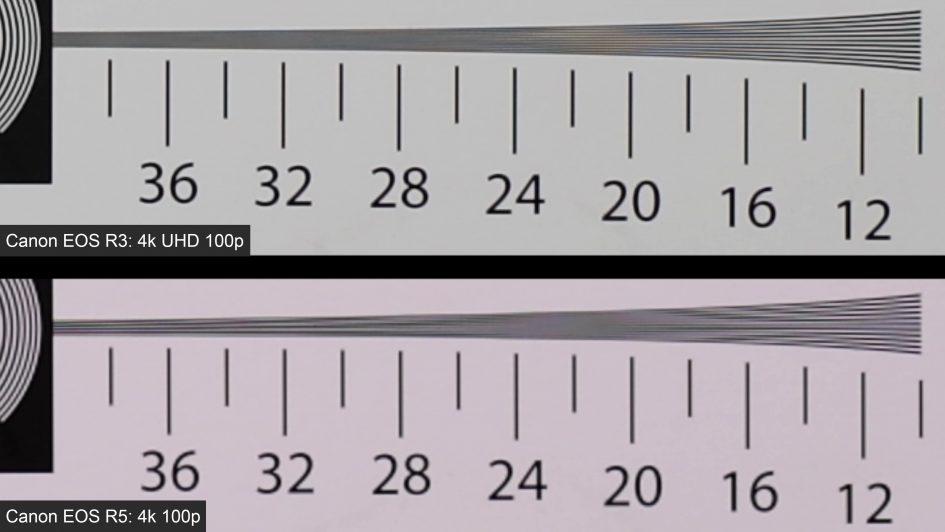
Above: And finally here’s the R3 in 4k 100p, first with the full chart, and now a closer look with the R3 at the top and the R5 at the bottom. Both cameras are resolving less in their high frame rates compared to their best quality 4k modes, but I’d say the R3 still enjoys slightly superior resolution here compared to the R5, and again can maintain it for longer clips with less chance of overheating. A great set of results for the R3.
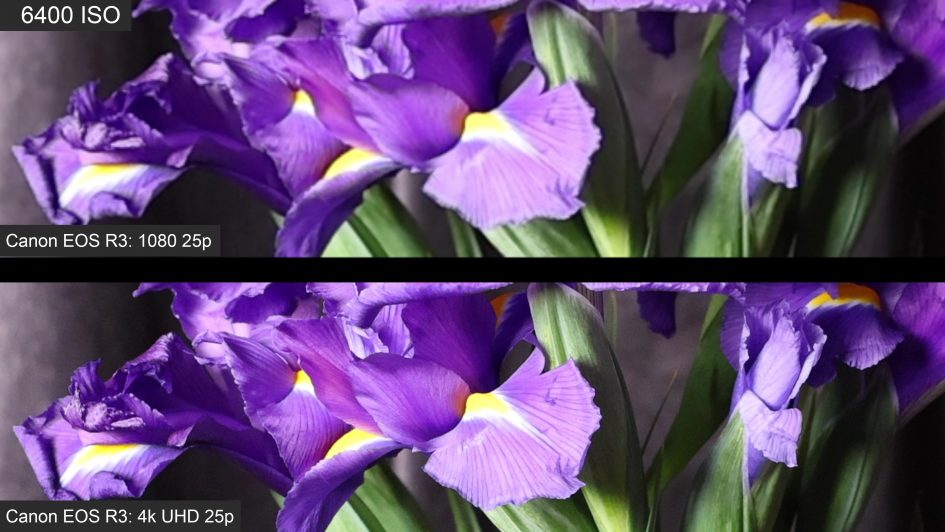
Above: Next to compare noise levels I filmed this still life scene in 1080 and 4k resolutions using the R3. Here’s the full image in 4k at 3200 ISO, and now for a closer look with the 1080 version at the top and the 4k version at the bottom, both at 3200 ISO. And now at 6400 ISO. Next at 12800 ISO. And finally at 25600 ISO, the maximum sensitivity for movies. I’ll make some direct comparisons for noise and dynamic range when I have a final production model.
Next for rolling shutter in 4k 50p at 100mm where even as I swing the camera back and forth, there’s impressively little skewing to worry about. This is a test where the R5 and R6 would suffer, so another great result for the R3.
Next up for some handheld footage to demonstrate the stabilisation in action. I filmed these clips in 4k 25p using the RF 24-70mm f2.8L using a combination of sensor shift and optical stabilisation. The heft of the R3 also makes it fairly easy to handhold without wobbles.
So here’s the mandatory vlogging section as I know there’s at least one person out there who’ll probably use it this way. First up at 24mm f2.8 with no stabilisation. Next with stabilisation enabled which like the R5 and R6 before it means sensor IBIS and optical stabilisation if your lens has it, which this one does. Next with additional digital movie stabilisation applied, so three types working together. And finally with enhanced digital stabilisation on top which incurs the usual crop making it too tight for vlogging with a 24mm. Returning to the standard IBIS and Optical IS though shows again how well the stabilisation can work for handheld work.
Check prices on the Canon EOS R3 at B&H, Adorama, WEX UK or Calumet.de. Alternatively get yourself a copy of my In Camera book or treat me to a coffee! Thanks!